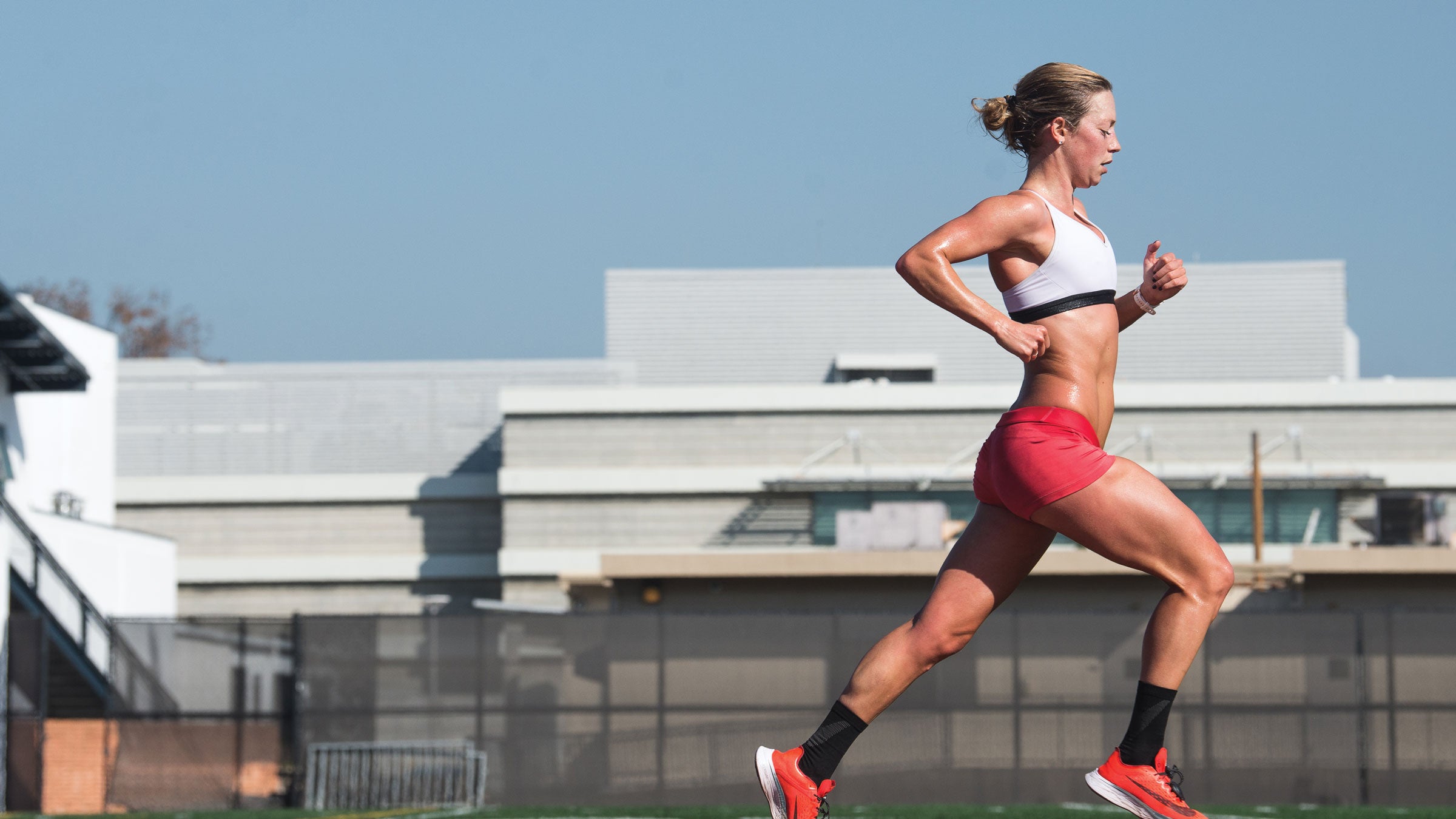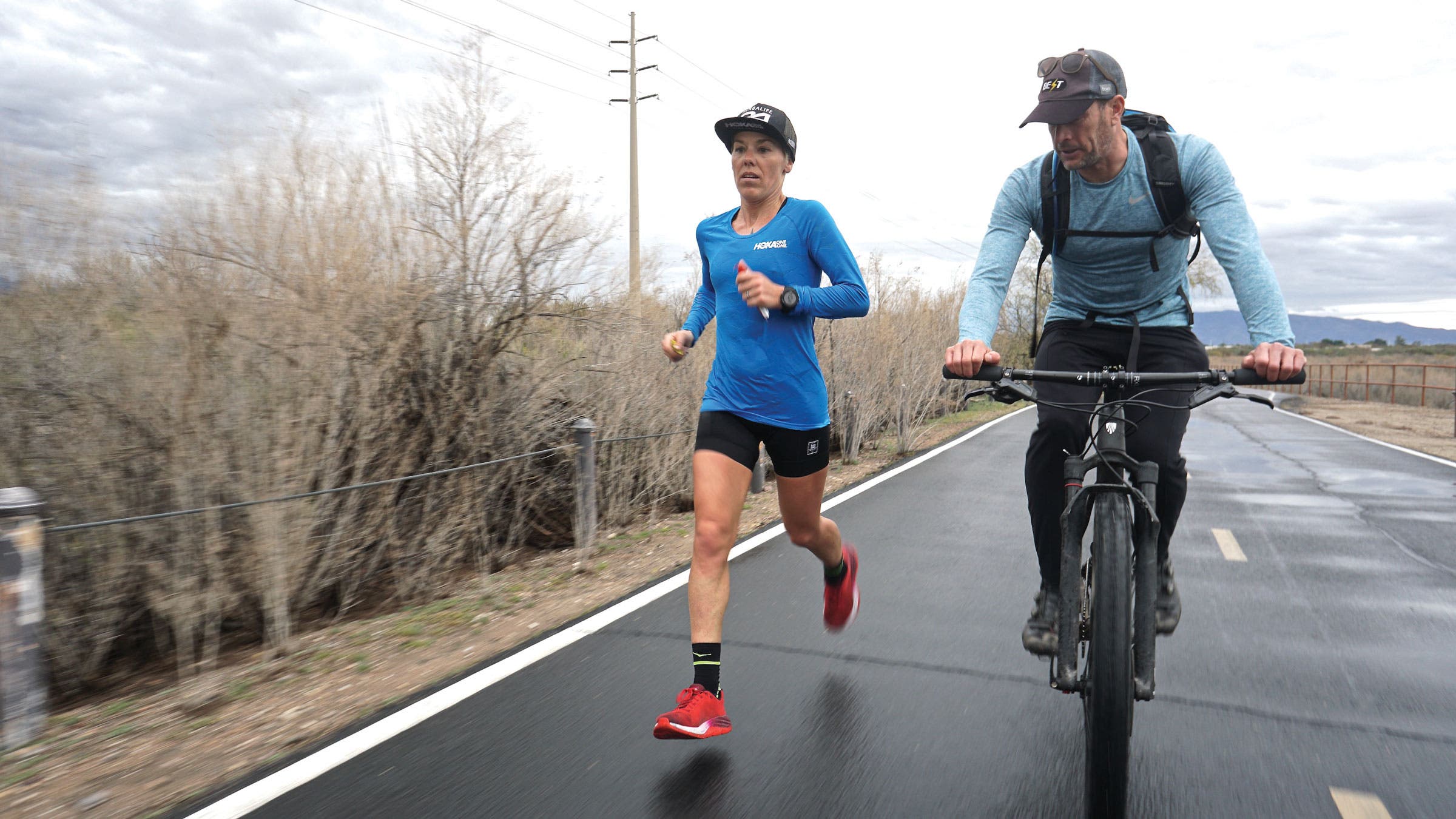Triathlete's Guide To Becoming A Better Runner

Former 70.3 world champion Holly Lawrence in full stride during a track workout coached by Sean Jefferson. (Photo: Sean Jefferson)
Watching any great runner in motion is a beautiful thing—they move through time and space with seemingly zero effort, just one long stride after another, with perfect hip extension and posture. Unfortunately, not everyone is blessed with such grace and form, and so we have to work hard at getting fitter, faster, and more efficient. It isn’t always an easy task, especially as an increase in misdirected motivation and enthusiasm can often translate into an increased chance of injury. As running can be the most “corrosive” of the three disciplines in triathlon, becoming a better runner is a project that demands patience, respect, and knowledge.
Olympian triathlete and coach Ryan Bolton has more than 25 years’ experience and is now uniquely positioned as a coach to both elite runners—he heads up The Harambee Project and coached Caroline Rotich to her 2015 Boston Marathon title—as has coached elite triathletes such as Ben Hoffman, Sam Long, and Heather Jackson (who is now crushing it as an ultrarunner). He is also the High Performance Technical Advisor to USA Triathlon.
Bolton knows too well that becoming a better runner happens with a consistent and smart approach to training — lessons that are there for anyone to learn. You don’t have to be a sub-three hour marathoner or a pro triathlete to be a smarter and better runner. Here’s how.
Start by building an aerobic base—don't try to win the race on the first workout.
How to become a better runner: Get neuro first
“There are a lot of factors to consider when we talk about how to improve our running—and training is only one of them,” Bolton said. “The first thing that comes to mind for me is that triathletes tend to lack the neuromuscular work needed to make gains in their running. It’s not just a case of running more or running faster—sure, increasing volume and speedwork can (and likely) will help—but neuromuscular work is the smarter and more efficient way to get there.”
According to Bolton, this doesn’t need to be complicated and can be done on a weekly basis. One simple thing? Adding strides or sprints to the end of an aerobic run. Strides are shorter accelerations of about 20 seconds, ideally on grass or a soft surface. Sprints should be 100m to 200m in length, building the effort on each one and with lots of recovery in between. “You want to be totally fresh for each one and hold your very best form,” he said. “Imagine you’re running down the finish chute at Kona, looking fantastic—that’s the kind of form we want to see.”
For an example of what this kind of workout would look like, check out this One-Hour Workout: Neuromuscular Run.
How to become a better runner: Figure out your form
Of course, perfect run form is not something that everyone is blessed with and debate has raged for years about how much time and effort inefficient runners should spend working on their form. It’s a debate that former pro triathlete and sub-four-minute miler Sean Jefferson pays little attention to. He now coaches a number of elite and age-group triathletes with his group, Passion Project—and he finds overly obsessing about form is rarely productive. “Forcing a runner to move their body in a certain way is usually inefficient and not sustainable for endurance events. I prefer to have my athletes run with a relaxed feeling,” he said. That means focusing on cues like: smooth cadence and light feet.
Runners want to focus on “light feet” because it usually leads to increased cadence and less ground contact time, which is a more efficient way of running, Jefferson said, adding cues such as “relaxed upper body, smooth arm carry, and steady gaze forward” can also help improve form. Hone in on your run form with these Cues to Improve Your Run Posture.
How to become a better runner: Combat the Ironman shuffle
When things start to hurt and we get tired our run form tends to fall apart—our cadence slows, our shoulders can slump—which is why learning to run well when tired is something both Bolton and Jefferson advise all aspiring triathlete runners to focus upon.
“Triathletes do tend to fall apart when running, especially in longer races, so anything you can do to improve this will pay off,” Bolton said. In addition to neuromuscular work, he advises working on strength both in the gym and in run-specific strength workouts, such as “tricking” your body into doing speed work on hills. Hills can naturally force you into better run form and help you build up that practice.
Frequently running off the bike and, once fit enough, doing quality run sessions after rides is also a key part of combating the end-of-race breakdown. “You want to hit higher-quality run workouts on fatigued legs, as fatigued as possible while still getting gains from the run,” he said. To master the brick workout, check out this primer: Get to Know the Brick Workout.
How to become a better runner: Pace yourself
Jefferson also advocates the importance of learning proper pacing, especially for newer or more inexperienced runners who might need to get that pace more ingrained in their legs and their mind. “The easiest way to learn how to properly pace is by doing intervals on a treadmill, track, or a flat loop—it needs to be repeatable,” he said. Test out different paces, see what you can maintain by heart rate and effort, and then you’ll know that pace when race day comes.
The other kind of pacing? Pacing your expectations. Diving into a run program that you hope will bring PRs galore without due consideration for proper ramping up of volume and intensity is a sure-fire way to get hurt. “Too much running too quickly leads to injury and knowing what’s right for each runner takes time, so it is far better to be patient and build up slowly with the primary goal of staying healthy,” Jefferson said. Pacing can be a tricky beast – master yours with the 3 Keys to Pacing Your Way to a New PR.
One rule of thumb is not to increase weekly mileage by more than 10% each week, if you’re at or over 25 miles/week. Below 25 miles/week, a weekly increase of 15-20% is OK as long as you’re not increasing intensity too, Bolton said. Start by building an aerobic base—don’t try to win the race on the first workout. “Running easy 10-minute miles can do magical things,” he said.
It might not seem glamorous, but if you’re smarter about that foundation, it’ll help you run faster in the long run.

How to become a better runner: Coach Ryan’s go-to run workouts
Neuromuscular Workout
Warm-up: 35 minutes of running at zone 1 (see table below for training zones)
Strides: 8 x 20 second strides on grass or a soft surface
Your focus is holding perfect form throughout your 20-second strides, accelerating and holding your one-mile race pace.
Walk or stand to recover for 90 seconds between each stride—don’t start your next stride until your heart rate and breathing have come down some.
Tip: Count your right foot strikes during each stride. A good goal is 30 strikes for each 20-second stride.
Cool down: Five minutes of jogging
Speed Workout
Warm-up: Jog a 15-minute warm-up, then include some strides and dynamic warm-up exercises
Workout: 4 x [1000m (on two minutes rest), 300m (on four minutes rest)]
Run the 1000m reps at high zone 4/low zone 5, then take the two-minute walk or jog recovery. Run the 300m fast, at a near all-out effort, while still in control. Really push the speed and intensity while still maintaining good form. Rest four minutes with a jog or walk. Repeat four times.
Cool down: 10 minutes of jogging
Pyramid Tempo Workout
Workout: This is a 75-minute straight run that starts easy and gets hard.
Start with 15 minutes of running smooth and steady in zone 1 to 2, then build to 15 minutes in zone 3, 15 minutes in zone 4 (this is tough!), then come back down with 15 minutes back in zone 3, and finish off with 15 minutes easier in zone 1 to 2.
Tip: You can make this workout shorter or longer, depending on ability and race distance, by changing the times of each segment.
How to become a better runner: Coach Sean’s go-to run workout
Threshold Running
Warm-up: Get in at least 20 minutes of running, building the effort to be ready to go
Workout: 2 x [5 x 1,000m (on one-minute rest between each 1,000m)]
Run these 1,000m repeats at 10K race pace with one-minute rest between each rep. Do five reps, then take five minutes rest of walking or easy jogging, and repeat.
Tip: If you don’t know your 10K race pace, then aim for 80-85% effort or right at the line between high zone 3 and bottom of zone 4.
The goal is to be very consistent at the fastest pace you can hold for the whole workout. If your first rep is 10 seconds faster than your last one, then you’ve done it wrong.
Cool down: At least 10-15 minutes of easy jogging
How to become a better runner: Do a run test
The purpose of an aerobic run test is to measure improvements in aerobic efficiency. Ideally, as you get fitter you’ll be able to run a faster pace at the same average heart rate. This test is not an all-out effort and can be replicated every four to eight weeks.
Warm-up: Run for 15 minutes, raising your heart rate to the 150 bpm range by the end.
Test: Run three miles on flat terrain—a track is preferred—aiming for a heart rate of 155 bpm on average. This should not feel like an all-out effort. Lock into the target heart rate and hold steady.
Record your splits and average heart rate for the three miles. Ideally, as your fitness improves, your pace drops for the same effort or heart rate level.
Cool down: Do 10 minutes easy and pat yourself on the back.
Table: Coach Ryan’s zone references
| Zone | System | Max. Heart Rate |
| Zone 1 | Aerobic Recovery | Under 74% |
| Zone 2 | Endurance | 74-79% |
| Zone 3 | Intensive Endurance | 80-83% |
| Zone 4 | Sub-Threshold | 84-89% |
| Zone 5A | Threshold | 90-93% |
| Zone 5B | Anaerobic Endurance | 94-97% |
| Zone 5C | Power | 98-100% |